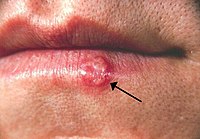
Photo from wikipedia
Chikungunya is an arboviral disease causing arthralgia which may develop into a debilitating chronic arthritis. In Mayotte, a French overseas department in the Indian Ocean, a chikungunya outbreak was reported… Click to show full abstract
Chikungunya is an arboviral disease causing arthralgia which may develop into a debilitating chronic arthritis. In Mayotte, a French overseas department in the Indian Ocean, a chikungunya outbreak was reported in 2006, affecting a third of the population. We aimed at assessing the chikungunya seroprevalence in this population, after over a decade from that epidemic. A multi-stage cross sectional household-based study exploring socio-demographic factors, and knowledge and attitude towards mosquito-borne disease prevention was carried out in 2019. Blood samples from participants aged 15–69 years were taken for chikungunya IgG serological testing. We analyzed associations between chikungunya serological status and selected factors using Poisson regression models, and estimated weighted and adjusted prevalence ratios (w/a PR). The weighted seroprevalence of chikungunya was 34.75% (n = 2853). Seropositivity for IgG anti-chikungunya virus was found associated with living in Mamoudzou (w/a PR = 1.49, 95%CI: 1.21–1.83) and North (w/a PR = 1.41, 95%CI: 1.08–1.84) sectors, being born in the Comoros islands (w/a PR = 1.30, 95%CI: 1.03–1.61), being a student or unpaid trainee (w/a PR = 1.35, 95%CI: 1.01–1.81), living in precarious housing (w/a PR = 1.30, 95%CI: 1.02–1.67), accessing water streams for bathing (w/a PR = 1.72, 95%CI: 1.1–2.7) and knowing that malaria is a mosquito-borne disease (w/a PR = 1.42, 95%CI: 1.21–1.83). Seropositivity was found inversely associated with high education level (w/a PR = 0.50, 95%CI: 0.29–0.86) and living in households with access to running water and toilets (w/a PR = 0.64, 95%CI: 0.51–0.80) (n = 1438). Our results indicate a long-lasting immunity from chikungunya exposure. However, the current population seroprevalence is not enough to protect from future outbreaks. Individuals naïve to chikungunya and living in precarious socio-economic conditions are likely to be at high risk of infection in future outbreaks. To prevent and prepare for future chikungunya epidemics, it is essential to address socio-economic inequalities as a priority, and to strengthen chikungunya surveillance in Mayotte.
Journal Title: PLOS ONE
Year Published: 2023
Link to full text (if available)
Share on Social Media: Sign Up to like & get
recommendations!